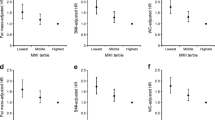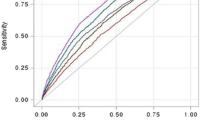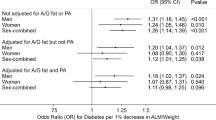Abstract
Objective
Age-related declines in skeletal muscle mass may confer significant metabolic consequences for older adults. Associations of low muscle mass and metabolic syndrome (MetS) in Caucasians, and comparisons with associations observed in Asian populations, have not been reported. We examined associations of low muscle mass and metabolic syndrome (MetS) in Asian and Caucasian middle-aged and older men and women using criteria for low muscle mass.
Design, Setting and Participants
Two population-based studies of Australian (Tasmanian Older Adult Cohort Study; TASOAC; N=1005) and Korean (Korean Sarcopenic Obesity Study; KSOS; N=376) community-dwelling adults, mean age 62 and 58 years, respectively.
Measurements
Appendicular lean mass (aLM) determined by dual-energy X-ray absorptiometry and normalised to height squared (aLM/Ht2), weight (aLM/Wt) or body mass index (aLM/BMI). Participants in the lowest sex-specific 20% for aLM measures were defined as having low muscle mass. MetS was defined according to National Cholesterol Education Program Adult Treatment Panel III criteria.
Results
Although Australians demonstrated generally unfavourable anthropometric and metabolic characteristics compared to Koreans, prevalence of MetS was similar (29.5% in Australians and 31.4% in Koreans, respectively). Low aLM/Ht2 was associated with significantly reduced likelihood of MetS in both Australians (OR: 0.30, 95% CI 0.19 - 0.46) and Koreans (OR: 0.31, 95% CI 0.16 – 0.62). Conversely, low aLM/BMI was associated with increased odds for MetS in Australians (OR: 1.78, 95% CI 1.12–2.84), but not Koreans (OR: 1.33, 95% CI = 0.67–2.64).
Conclusion
Low aLM/BMI is associated with significantly increased likelihood of MetS in Australian adults, but not Koreans, suggesting potential differences in effects of low muscle mass relative to body mass on cardiometabolic health in Caucasian and Asian middle-aged and older adults. Low muscle mass relative to height is associated with reduced likelihood of MetS in both populations.
Similar content being viewed by others

References
Alberti KGMM, Zimmet P, Shaw J. The metabolic syndrome - a new worldwide definition. Lancet 2005;366:1059–1062
Grundy SM. Metabolic syndrome pandemic. Arterioscler Thromb Vasc Biol 2008;28:629–636
Lim S, Shin H, Song JH, Kwak SH, Kang SM, Yoon JW, Choi SH, Cho SI, Park KS, Lee HK. Increasing Prevalence of Metabolic Syndrome in Korea The Korean National Health and Nutrition Examination Survey for 1998–2007. Diabetes Care 2011;34:1323–1328
Choi K, Lee J, Kim K, Kim D, Kim S, Shin D, Kim N, Park I, Choi D, Baik S. Factor analysis of the metabolic syndrome among elderly Koreans—the South-west Seoul Study. Diabet Med 2003;20:99–104
Walston JD. Sarcopenia in older adults. Curr Opin Rheumatol 2012;24:623–627
Karakelides H, Nair KS. Sarcopenia of aging and its metabolic impact. Curr Top Dev Biol 2005;68:123–148
Kim TN, Park MS, Yang SJ, Yoo HJ, Kang HJ, Song W, Seo JA, Kim SG, Kim NH, Baik SH. Prevalence and Determinant Factors of Sarcopenia in Patients With Type 2 Diabetes The Korean Sarcopenic Obesity Study (KSOS). Diabetes Care 2010;33:1497–1499
Bijlsma A, Meskers C, Ling C, Narici M, Kurrle S, Cameron I, Westendorp R, Maier A. Defining sarcopenia: The impact of different diagnostic criteria on the prevalence of sarcopenia in a large middle aged cohort. Age 2013;35:871–881
Lim S, Kim JH, Yoon JW, Kang SM, Choi SH, Park YJ, Kim KW, Lim JY, Park KS, Jang HC. Sarcopenic obesity: prevalence and association with metabolic syndrome in the Korean Longitudinal Study on Health and Aging (KLoSHA). Diabetes Care 2010;33:1652–1654
Lim K, Yang S, Kim T, Yoo H, Kang H, Song W, Baik S, Choi D, Choi K. The association between the ratio of visceral fat to thigh muscle area and metabolic syndrome: the Korean Sarcopenic Obesity Study (KSOS). Clin Endocrinol (Oxf) 2010;73:588–594
Kim TN, Park MS, Lim KI, Yang SJ, Yoo HJ, Kang HJ, Song W, Seo JA, Kim SG, Kim NH. Skeletal muscle mass to visceral fat area ratio is associated with metabolic syndrome and arterial stiffness: the Korean Sarcopenic Obesity Study (KSOS). Diabetes Res Clin Pract 2011;93:285–291
Chung J-Y, Kang H-T, Lee D-C, Lee H-R, Lee Y-J. Body composition and its association with cardiometabolic risk factors in the elderly: A focus on sarcopenic obesity. Arch Gerontol Geriatr 2013;56:270–278
Park SH, Park JH, Park HY, Jang HJ, Kim HK, Park J, Shin KJ, Lee JG, Moon YS. Additional role of sarcopenia to waist circumference in predicting the odds of metabolic syndrome. Clin Nutr 2014;33:668–672
Kim KM, Lim S, Choi SH, Kim JH, Shin CS, Park KS, Jang HC. Cardiometabolic Implication of Sarcopenia: The Korea National Health and Nutrition Examination Study (KNHANES) 2008–2010. IJC Metabolic & Endocrine 2014;4:63–69
Studenski SA, Peters KW, Alley DE, Cawthon PM, McLean RR, Harris TB, Ferrucci L, Guralnik JM, Fragala MS, Kenny AM. The FNIH Sarcopenia Project: Rationale, Study Description, Conference Recommendations, and Final Estimates. J Gerontol A Biol Sci Med Sci 2014;69:547–558
Woo J, Arai H, Ng TP, Sayer AA, Wong M, Syddall H, Yamada M, Zeng P, Wu S, Zhang TM. Ethnic and geographic variations in muscle mass, muscle strength and physical performance measures. Eur Geriatr Med 2014;5:155–164
Castaneda C, Janssen I, Castaneda C, Janssen I. Ethnic comparisons of sarcopenia and obesity in diabetes. Ethn Dis 2005;15:664–670
Kim T, Yang S, Yoo H, Lim K, Kang H, Song W, Seo J, Kim S, Kim N, Baik S. Prevalence of sarcopenia and sarcopenic obesity in Korean adults: the Korean sarcopenic obesity study. Int J Obes 2009;33:885–892
Ostlund Jr RE, Staten M, Kohrt WM, Schultz J, Malley M. The ratio of waist-to-hip circumference, plasma insulin level, and glucose intolerance as independent predictors of the HDL2 cholesterol level in older adults. N Engl J Med 1990;322:229–234
Delmonico MJ, Harris TB, Lee JS, Visser M, Nevitt M, Kritchevsky SB, Tylavsky FA, Newman AB. Alternative definitions of sarcopenia, lower extremity performance, and functional impairment with aging in older men and women. J Am Geriatr Soc 2007;55:769–774
Baumgartner RN, Romero L, Garry PJ, Heymsfield SB, Koehler KM, Gallagher D, Ross RR, Lindeman RD. Epidemiology of sarcopenia among the elderly in New Mexico. Am J Epidemiol 1998;147:755–763
Janssen I, Heymsfield SB, Ross R. Low relative skeletal muscle mass (sarcopenia) in older persons is associated with functional impairment and physical disability. J Am Geriatr Soc 2002;50:889–896
Schmidt MD, Cleland VJ, Shaw K, Dwyer T, Venn AJ. Cardiometabolic risk in younger and older adults across an index of ambulatory activity. Am J Prev Med 2009;37:278–284
Grundy SM, Cleeman JI, Daniels SR, Donato KA, Eckel RH, Franklin BA, Gordon DJ, Krauss RM, Savage PJ, Smith SC. Diagnosis and management of the metabolic syndrome. An American Heart Association/National Heart, Lung, and Blood Institute scientific statement. Circulation 2005;112:2735–2752
Srikanthan P, Hevener AL, Karlamangla AS. Sarcopenia exacerbates obesity-associated insulin resistance and dysglycemia: findings from the National Health and Nutrition Examination Survey III. PLoS ONE 2010;5:e10805
Park SW, Goodpaster BH, Strotmeyer ES, de Rekeneire N, Harris TB, Schwartz AV, Tylavsky FA, Newman AB. Decreased muscle strength and quality in older adults with type 2 diabetes The Health, Aging, and Body Composition Study. Diabetes 2006;55:1813–1818
Moon S-S. Low skeletal muscle mass is associated with insulin resistance, diabetes, and metabolic syndrome in the Korean population: The Korea National Health and Nutrition Examination Survey (KNHANES) 2009–2010. Endocr J 2014;61:61–70
Newman AB, Kupelian V, Visser M, Simonsick E, Goodpaster B, Nevitt M, Kritchevsky SB, Tylavsky FA, Rubin SM, Harris TB. Sarcopenia: alternative definitions and associations with lower extremity function. J Am Geriatr Soc 2003;51:1602–1609
Sanada K, Iemitsu M, Murakami H, Gando Y, Kawano H, Kawakami R, Tabata I, Miyachi M. Adverse effects of coexistence of sarcopenia and metabolic syndrome in Japanese women. Eur J Clin Nutr 2012;66:1093–1098
Zhou J, Zhang Q, Yuan X, Wang J, Li C, Sheng H, Qu S, Li H. Association between metabolic syndrome and osteoporosis: A meta-analysis. Bone 2013;57:30–35
Penninx BW, Nicklas BJ, Newman AB, Harris TB, Goodpaster BH, Satterfield S, De Rekeneire N, Yaffe K, Pahor M, Kritchevsky SB. Metabolic syndrome and physical decline in older persons: results from the Health, Aging And Body Composition Study. J Gerontol A Biol Sci Med Sci 2009;64A:96–102
Frank A, Farthing J, Chilibeck P, Arnold C, Olszynski W, Kontulainen S. Community-dwelling female fallers have lower muscle density in their lower legs than non-fallers: evidence from the Saskatoon Canadian Multicentre Osteoporosis Study (CaMos) cohort. J Nutr Health Aging 2015;19:113–120
Cooper C, Fielding R, Visser M, van Loon L, Rolland Y, Orwoll E, Reid K, Boonen S, Dere W, Epstein S. Tools in the Assessment of Sarcopenia. Calcif Tissue Int 2013;93:201–210
Sayer AA, Syddall HE, Dennison EM, Martin HJ, Phillips DIW, Cooper C, Byrne CD. Grip strength and the metabolic syndrome: Findings from the Hertfordshire Cohort Study. QJM 2007;100:707–713
Senechal M, McGavock JM, Church TS, Lee D-C, Earnest CP, Sui X, Blair SN. Cut Points of Muscle Strength Associated with Metabolic Syndrome in Men. Med Sci
Author information
Authors and Affiliations
Corresponding author
Rights and permissions
About this article
Cite this article
Scott, D., Park, M.S., Kim, T.N. et al. Associations of low muscle mass and the metabolic syndrome in Caucasian and Asian middle-aged and older adults. J Nutr Health Aging 20, 248–255 (2016). https://doi.org/10.1007/s12603-015-0559-z
Received:
Accepted:
Published:
Issue Date:
DOI: https://doi.org/10.1007/s12603-015-0559-z



